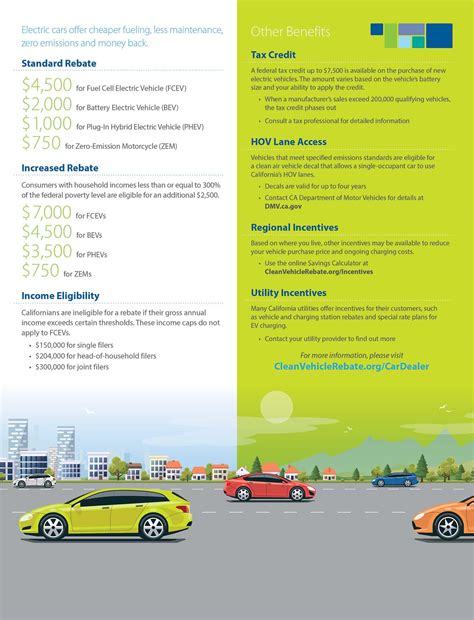Revving Up Sustainability: What You Need to Know About the Clean Air Vehicle Rebate
As the world increasingly focuses on combating climate change and fostering sustainable practices, the automotive industry is undergoing a significant transformation. One of the key components of this initiative is the Clean Air Vehicle Rebate, designed to encourage consumers to adopt eco-friendly vehicles. In this article, we will explore the Clean Air Vehicle Rebate, its benefits, eligibility criteria, application process, and how it plays a pivotal role in promoting sustainability.
The Importance of Sustainability in Transportation
Transportation is one of the largest contributors to greenhouse gas emissions worldwide. The shift towards sustainable transportation is crucial for reducing our carbon footprint and improving air quality. Electric vehicles (EVs) and other clean-air vehicles pop into the discussion as viable solutions to diminish these emissions while promoting renewable energy sources.
What is the Clean Air Vehicle Rebate?
The Clean Air Vehicle Rebate is a financial incentive provided by various government entities to encourage the purchase and leasing of zero-emission and plug-in hybrid vehicles. The overarching goal is to stimulate demand for cleaner alternatives to traditional gasoline-powered vehicles, which significantly contribute to air pollution.
Benefits of the Clean Air Vehicle Rebate
There are numerous advantages associated with the Clean Air Vehicle Rebate, including:
- Financial Incentives: Buyers can receive substantial rebates, which can significantly reduce the overall cost of purchasing a new electric vehicle.
- Reduced Operating Costs: Electric vehicles generally have lower operating costs than gasoline vehicles, allowing owners to save on fuel and maintenance over time.
- Environmental Impact: By opting for clean-air vehicles, consumers contribute to reduced greenhouse gas emissions and improved air quality in their communities.
- State and Local Benefits: Many states and local governments also offer additional incentives, making the transition to clean vehicles even more appealing.
Eligibility Criteria
To qualify for the Clean Air Vehicle Rebate, applicants generally must meet certain criteria, which may vary by state or program. Some common requirements include:
- Vehicle Type: The vehicle must be a zero-emission or plug-in hybrid model that meets specific regulatory standards.
- Purchaser Eligibility: The applicant must be the owner or lessee of the vehicle and must have registered the vehicle with the relevant government body.
- Income Limits: Some programs may have income restrictions, ensuring that financial benefits go to those who need them most.
- Application Timeline: Applicants usually must submit their rebate application within a certain period after the vehicle purchase or lease.
Application Process
The process of applying for the Clean Air Vehicle Rebate typically involves the following steps:
- Purchase or Lease a Qualified Vehicle: Choose a clean-air vehicle that meets eligibility requirements.
- Collect Required Documentation: Gather necessary paperwork, including proof of purchase, vehicle registration, and any required income documentation.
- Submit the Application: Complete and submit the application form online or via mail, ensuring all documentation is included.
- Receive Your Rebate: If approved, you will receive your rebate in the form of a check or direct deposit, often within a few weeks.
The Role of Clean Air Vehicle Rebates in Promoting Sustainability
Rebates are more than just financial incentives; they represent a shift in how society prioritizes sustainability. By removing some of the financial barrier to entry, they make it easier for individuals and families to opt for cleaner alternatives, thereby accelerating the adoption of electric vehicles and plug-in hybrids. This, in turn, contributes to a larger societal shift towards renewable energy sources and reduced carbon emissions.
Challenges and Criticisms
While the Clean Air Vehicle Rebate program has been effective, it is not without its challenges and criticisms. Some common points of contention include:
- Funding Limitations: Many programs face budget constraints that could limit the availability of funds for rebates, frustrating many potential applicants.
- Equity Concerns: There are discussions surrounding whether these programs adequately serve lower-income households, who may benefit the most from such incentives but face barriers to EV ownership.
- Market Limitations: In some regions, the availability of clean-air vehicles can be limited, making it difficult for residents to take advantage of rebate programs.
Conclusion
The Clean Air Vehicle Rebate is an essential tool in the push for a more sustainable and eco-friendly automotive industry. By providing financial incentives for the purchase and leasing of clean-air vehicles, this program encourages consumers to make environmentally conscious decisions that benefit both themselves and the planet. As we continue to confront the challenges of climate change and air pollution, programs like these are crucial in propelling us toward a more sustainable future.
FAQs
1. How much is the Clean Air Vehicle Rebate?
The rebate amount varies by state and vehicle type, but it can range anywhere from $1,000 to $7,500 or more.
2. Are there any income restrictions to qualify for the rebate?
Some states do have income limits in place for eligibility, designed to ensure that those who could benefit the most from the rebate receive it.
3. Can I apply for the rebate after purchasing my vehicle?
Yes, applicants generally must submit their applications within a specific period after vehicle purchase or lease, usually within a few months.
4. What types of vehicles qualify for the rebate?
Qualified vehicles typically include zero-emission vehicles (ZEVs) and plug-in hybrid electric vehicles (PHEVs) that meet certain regulatory standards.
5. Can I get additional incentives on top of the Clean Air Vehicle Rebate?
Yes, many states and local governments offer additional incentives that can be combined with the Clean Air Vehicle Rebate, making it even more affordable to purchase an eco-friendly vehicle.
Feel free to customize the content or format it further to fit specific needs!
Download Clean Air Vehicle Rebate
